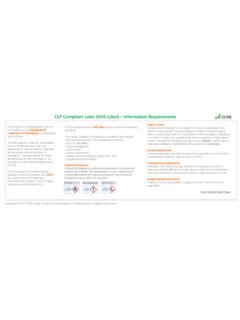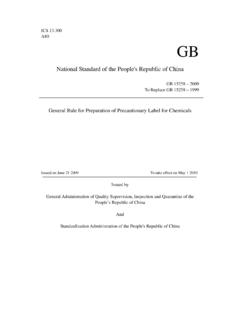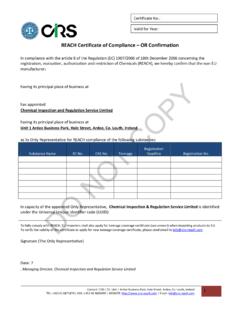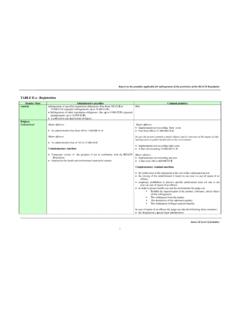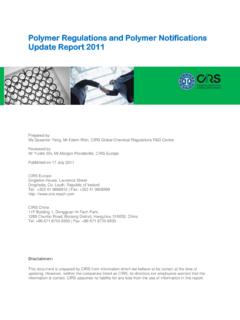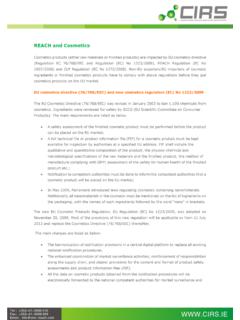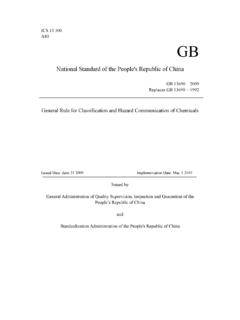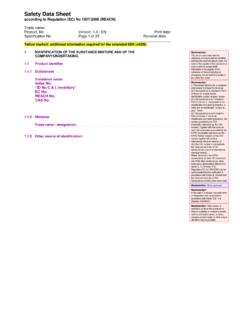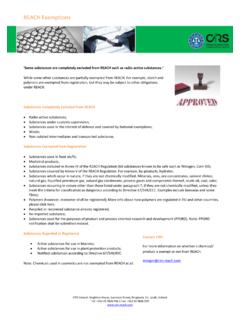Transcription of Understanding Cut-off Value and Concentration …
1 Enabling Chemical Compliance for A Safer WorldUnderstanding Cut-off Value and Concentration Limits in CLP Regulation and China GHS23 August 2011 Yunbo Shi, CIRS Ireland1 About the Presenter2 Yunbo Shi, Managing DirectorTel: +353 41 9806916 | Email: Chemistry, University of Maryland, College Park Chemistry, University of Science and Technology of China About Us (CIRS- ) Chemical regulatory consulting +hazardous substances testing 100employees, 15chemists and toxicologists, 2large operations (China & Ireland) REACH, CLP, China REACH, China GHS for industrial chemicals Consulting services for food additives, cosmetics, and pesticides Hazardous substances testing for articlesMore info Few Polls3 Table of ContentsClassification of Substances and MixturesIntro to Cut-off Value and Concentration LimitsCLP Regulation vs China GHST ransform REACH SDS into Chinese GHS SDS4 Table of ContentsClassification of Substances and MixturesIntro to Cut-off Value and Concentration LimitsCLP Regulation vs China GHST ransform REACH SDS into Chinese GHS SDS5 Classification.
2 Identification of hazard classes for substance and mixturePhysical Hazards16 ClassesExplosive, Flammable gases, Flammable aerosols, Oxidising gases, Gas under pressure, Flammable liquids, Flammable solids, Pyrophoric liquids, Pyrophoric solids, Self-heating substances and mixtures, substances and mixtures which are in contact with water emit flammable gases, Oxidising liquids, Oxidising solids, Organic peroxides, Corrosive to metals, Self-reactive substances and Hazards10 ClassesAcute toxicity, Skin corrosion/irritation, Serious eye damage/irritation, Respiratory or skin sensitization, Germ cell mutagenicity, Carcinogenicity, Reproductive toxicity, Specific target organ toxicity-single exposure, Specific target organ toxicity-repeated exposure,Aspiration Hazard(*)EnvironmentalHazards2 ClassesHazardous to the aquatic environment Hazardous to ozone layer(*)* Does not exist in China GHS6 Classification determines hazard communication elements (SDS + label)Example, Respiratory or skin sensitisation Harmonized Hazard Description, Pictogram and Precautionary Statements Elements in Safety Data Sheet and Chemical Safety Label7 Classification Criteria for SubstancesBased on available data such as test data & QSAR(*)Classification Criteria for Acute Toxicity Category 3,4* Classification criteria for substances containing additives and impurities are similar to criteria for mixtures.
3 8 Classification of MixturesAre available test data for the mixture sufficient for classification?Is theredata available on similar tested mixtures and individual hazardous ingredients?Are hazard data available for all or some ingredients?Is it possible to apply any of the bridging principles?NNYYC lassify the mixture accordinglyYNUse calculation or Cut-off Value / Concentration limits to classifyYClassifi. of majority of physical hazards based on testingHealth and environ. hazards: test data not easily available9 DilutionTested mixture A is diluted with less or equally hazardous ingredient B. A+B=A;BatchingMixture A & B are two batches produced under same conditions. A=B; Concentration of highly hazardous mixturesMixture A is classified at its highest hazard category, for example, acute toxicity category 1.
4 B is more concentrated mixture of A. B=A;Interpolation within one toxicity categoryMixture A and B share the same classifi. and active hazardous ingredient. If the concent. of the hazardous ingredient in mixture C is in-between, C=A=B;Substantially similar mixturesMixtures A+B, C+B, A =C in concent. & classification. A+B=B+ of Mixtures: Bridging Principles10 Acute Toxicity Classification of Mixtures: Calculation Method11 Total Concentration of theingredient(s) with unknown toxicity is <= 10 %;Total Concentration of theingredient(s) with unknown toxicity is >10 %;Used when test data on mixture is not available or abridging principle cannot be applied;Also used to classify substances containing hazardous additives or impurities;Available only for health hazards and environmental hazards.
5 Classification of Mixtures: Use of Cut-off Value and Concentration Limits12 Table of ContentsClassification of Substances and MixturesIntro to Cut-off Value and Concentration LimitsCLP Regulation vs China GHST ransform REACH SDS into Chinese GHS SDS13 Cut-off values are the minimum concentrations for a substance (either as additive, impurity or an individual constituent of mixture) to be taken into account for classification classified substance present in a Concentration above the Cut-off Value might not trigger classification of the substance or of Cut-off Value14 Generic Cut-off Value -Table of Annex I to CLP Note 1,2: There is a presumption that an ingredient present at a Concentration of less than 1% can still be relevant for classifying the mixture for skin irritation or eye irritation.
6 Note 3: Generally, for substances classified as Acute Category 1 or Chronic Category 1 the Concentration to be taken into account is (0,1/M) %; M= : How Cut-off Value Is Used?Ingredientw%LD50(mg/kg)Classificati onAnionic >5000 Not classifiedThickening Irrit. 2 Water90 Not classifiedIngredientw%LD50(mg/kg)Classif icationAnionic >5000 Not classifiedThickening Irrit. 2 Water90 Not classified Example 1: Below Cut-off Value 1%. The mixture is not classified as Skin Irrit. 2. Example 2: Above Cut-off Value 1%. The mixture might be classified. 16 Concentration limits are the minimum concentrations for a substance which trigger the classification of a mixture if exceeded by the individual concentrationor the sum of concentrationsof relevant substancesAdditivity concepts (the sum of concentrations ) are not applicable to all hazard of Concentration Limits17 Cut-off Value vs Concentration Limits18 Concentration LimitsCut-off ValueTrigger ClassificationNo contribution to classificationNeeds to be taken into accountMight not trigger classificationExample: Respiratory/Skin Sensitiser from CLPG eneric Concentration Limits -Part 3-5 of CLP19 Example 1: How Concentration Limits Are Used for Classification?
7 Ingredientw%LD50(mg/kg)ClassificationAni onic >5000 Not classifiedThickening Sens. 1 Skin Irrit. 2 Water90 Not classified Above Concentration limit 1% for Skin Sens. 1. The mixture is classified as Skin Sens 1 Above Cut-off Value 1%; Below Concentration limit 10% for Skin Irrit. 2; The mixture is not classified as Skin Irrit 220 Example 2: How Concentration Limits Are Used for Classification? The sum of Concentration exceeds Concentration limit for Skin Irrit. 2 10%; The mixture is classified as Skin Irrit 2;Ingredientw%LD50(mg/kg)ClassificationA nionic >5000 Not classifiedThickening Sens. 1 Skin Irrit. 2 Solvent A9 Skin Irrit. 2 Water80 Not classified21! Additivity concepts are not applicable to every hazard and respiratory sensitisers;germ cell mutagenicity;carcinogenicity;reproductiv e toxicity;specific target organ toxicity, single and repeated exposure, categories 1 and 2;aspiration hazard (plus consideration of viscosity of the final mixture);skin corrosion/irritation in some special cases (for example strong acid and base, see CLP Annex I, ); andserious eye damage/eye irritation in some special cases (see CLP Annex I, ).
8 Additivity concepts are not applied to the following classes:22skin corrosion/irritation (besides the cases mentioned in CLP Annex I, );serious eye damage/eye irritation (besides the cases mentioned in CLP Annex I, );specific target organ toxicity, single exposure Category 3 (respiratory tract irritation);specific target organ toxicity, single exposure Category 3 (narcotic effects); andacute and chronic aquatic concepts are used for the following hazard classes:23 Substance specific;Takes precedence over any other Concentration limits;Could be loweror higherthan generic Concentration limits if proven by data;Only available for health hazards;Specific Concentration Limits24 ExampleCarbon Disulphide, Reproductive Toxicant Category 2 Generic Concentration Limit: C>=3%;Specific Concentration Limit: C>=1%;Example: Specific Concentration Limits in CLP25 Setting Specific Concentration Limits Not available for all health hazards Set by manufacturer, importer or downstream user26 Table of ContentsClassification of Substances and MixturesIntro to Cut-off Value and Concentration LimitsCLP Regulation vs China GHST ransform REACH SDS into Chinese GHS SDS27 CLP Regulation vs China GHSI temsChina GHSEU CLP RegulationUN VersionUN GHS 2003+2007UN GHS 2009 3rd RevHazard Classes26 classes, no aspiration hazard28 classes, aspiration hazard, harzardous to ozone Building BlocksAcute Toxicity, Cate.
9 5 Acute Aquatic Cate. 2 & 3 Flammbale Liquids Cate. 4 Skin Corrionsion/Irritant 3 Serious eye damage/eye irritation, Cate. 2B (Do not exist in CLP)H304: May be fatal if swallowed and enters airways H335: STOT Single Exposure Category 3, Respiratory tract irritation H336: STOT Single exposure, Category 3, Narcosis EUxx: Hazardous to the ozone layer and other supplemental hazards (Do not exist in China GHS)PictogramFrame: Both red and blackFrame: Red; Minimum size requirement;Acute Toxicity for Gases Category 4 Inhalation(Gas) LC50>2500ppm, <5000ppmH332: Inhalation(Gas) LC50>2500ppm, <20000ppmSimplified labelYesNo28 China GHS vs CLP: Cut-off Value and Concentration LimitsNo generic Cut-off Value or Cut-off Value and Concentration limits are combined; Concentration limits are usually consistent with generic Concentration limits in CLP regulation;No substance specific Concentration limits due to lack of data and harmonized inventory (annex VI of CLP);For one hazard class, multiple Concentration limits might be available (example, reproductive toxicant);29 China GHS vs CLP: Cut-off Value and Concentration LimitsExample: Reproductive Toxicant (from GB 20598-2006) UN GHS gives two Concentration limits.
10 China does the GHS vs CLP: Cut-off Value and Concentration LimitsExample: Reproductive Toxicant (from CLP) CLP differentiates Cut-off Value and Concentration limits; Concentration limit are and 3% under CLP. More clearly defined. 31 China GHS vs CLP: Cut-off Value and Concentration LimitsExample: Reproductive Toxicant (from GB 20598-2006) CIRS s suggestion: consistent with CLP and 3%; is the minimum Concentration for SDS (from note);32a substance posing human health or environmental hazards with a Concentration of >1%w/w for non-gaseous mixtures or for gas;a substance that is PBT, or vPvB, or SVHC in an individual Concentration of % by weight for mixtures that are solid or liquids ( , non-gaseous mixtures);Similar to China s requirementChina GHS vs CLP: Required Ingredient Info in SDS for Un-classified Mixture Under CLP33 China GHS vs CLP: Required Ingredient Info in SDS for Classified Mixture Under CLP A combined list of generic Cut-off Value and Concentration limit in CLP The difference between EU and China is marked in red If specific Concentration limit or M-factor is available, the lowest of Concentration limit in this table, specific Concentration limit or specific Cut-off Value shall be used.
